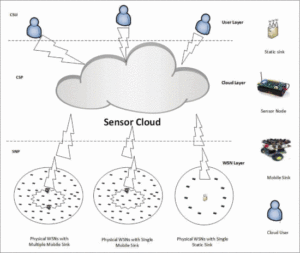In recent years, Wireless Sensor Networks (WSNs) have been used in many vital areas, including weather forecasting, security, environmental monitoring, health care, and industry. However, efficiently administrating the enormous volumes of data generated by WSNs is a key concern. Robust and scalable high-performance computing and storage infrastructures are necessary for processing and storing WSN data in real-time—combining WSNs and cloud computing to create sensor clouds can address this issue.
In an article in IEEE Internet of Things Magazine, researchers investigate, highlight, and report data collection techniques—highlighting the significance of sensor clouds. The article covers their definitions, architectures, and applications by categorizing and classifying data collection methods in WSNs and sensor clouds. Key research challenges for future work and use cases in this research domain are also discussed.
Technologies Working Together
The use of sensor clouds to gather, store, and interpret massive volumes of data has increased recently, especially in sensor networks that generate huge volumes of data. As a result, end users can examine and keep track of the data stored and processed remotely using a mobile device. The researchers first define the key technologies considered:
- Wireless Sensor Networks: A WSN is a sensor network composed of sensor nodes. These sensor nodes are self-directed, small, and low-powered, sometimes called “mote.” They retrieve data from the deployed environment and transfer it to a gateway using single- or multiple-hop data transmission modes.
- Sensor Cloud: A sensor cloud is a different platform for the storage, display, and remote management of sensor data that offers excellent data scalability, quick visualization, and user-programmable analysis.
The authors note that WSN’s capacity to support several cloud applications can increase its effectiveness. The WSN’s services, such as environmental inspections, health checks, and detecting landslides or forest fires, can be added to the cloud to enhance its services significantly.

Sensor cloud description.
The article outlines the most recent research on data collecting in WSNs and sensor clouds. Five aspects of data collection are considered: the data collection in WSNs using a single static sink, multiple static sinks, a single mobile sink, multiple mobile sinks, and the data collection in a sensor cloud.
Experimenting with Data Collection in Sensor Clouds
To better understand the benefits of the sensor cloud, the researchers implemented a small testbed to run experiments. As IoT devices tend to be low-computing devices, Raspberry Pi was chosen as the IoT device. The researchers implemented an automatic smart room temperature control system in the testbed setup. In that system, the Raspberry Pi collects the temperature data of a room every second using a temperature sensor and controls the HVAC system.
The experimental results demonstrate that considering all aspects, the computation on the edge server scenario is more appropriate for real-time applications such as health monitoring sensors, and military use. In contrast, the computation on a remote cloud scenario is suitable for applications without delay sensitivity, such as agricultural sensors. However, in some scenarios, such as data aggregation from air quality monitoring sensors spread over a country, a cloud-based scenario is the only feasible option compared to an edge computing scenario.
Application Scenarios
The authors present data collection use cases in different application scenarios, aiming to show how data are collected and stored in WSNs, sensor clouds, and IoT models.
Agricultural Sector
In agriculture, wireless sensors are employed to monitor crop progress. Tiny sensors are implanted into plant crops to identify the critical stages of plant growth. In this context, gathering data rapidly with little energy usage and trustworthy data transfer requires data gathering from these sensors. These sensors can inform farmers about water shortages, ultraviolet light, insect infestations, and weather variations. Data is assessed to give plants the best agricultural solutions.
Health Sector
Using sensor cloud architecture, centralized services are offered in the health industry. This platform allows users to save, gather, and share their health data. The data on the platform is accessible via pharmacies, healthcare professionals, health labs, and cloud service providers.
Military Use
Sensors are used in these systems to detect cars and control traffic signals. Video cameras are, therefore, used to keep an eye on busy route portions. WSNs are utilized in the military to monitor enemy forces, monitor battlefields, and identify biological and chemical attacks. The sensor cloud can help with this issue by providing a secure infrastructure that can be used only for military purposes.
Transport Monitoring
Navigation, traffic light control, automatic number plate recognition, emergency vehicle notification, and toll collection are only a few examples of the various transport monitoring systems. Sensor data can be transferred to a central location for fusion and processing.
Wearable Devices
These tools keep tabs on patient’s health or find criminals. Patients can be monitored to see if their health improves based on sleeping, moving about, walking, and other behaviors. The location of criminals under home arrest can also be used to track them. Wireless interfaces such as Bluetooth and ultra-wideband collect data from wearable technology.
Temperature Monitoring
The temperature is typically measured in tourist areas to entice visitors to seasonal and nonseasonal events. In this scenario, sensors are installed to provide temperature data to a sensor cloud or a wireless sensor network for informed tourism decision-making.
Open Challenges and Future Directions
To close, the researchers outline significant research challenges and future directions. These include big data collection, sensor node deployment, data security, data aggregation, distribution of control messages, on-time data delivery, data collection delay, energy management, data communication, quality of service (QoS), and service scalability.
Interested in learning more about Cloud Computing? IEEE offers continuing education with the IEEE Introduction to Edge Computing Course Program and Cloud Computing Course Program course programs to smartly implement digital tools into your organization.
Interested in acquiring full-text access for your entire organization? Full articles available with purchase or subscription. Contact us to see if your organization qualifies for a free trial.




